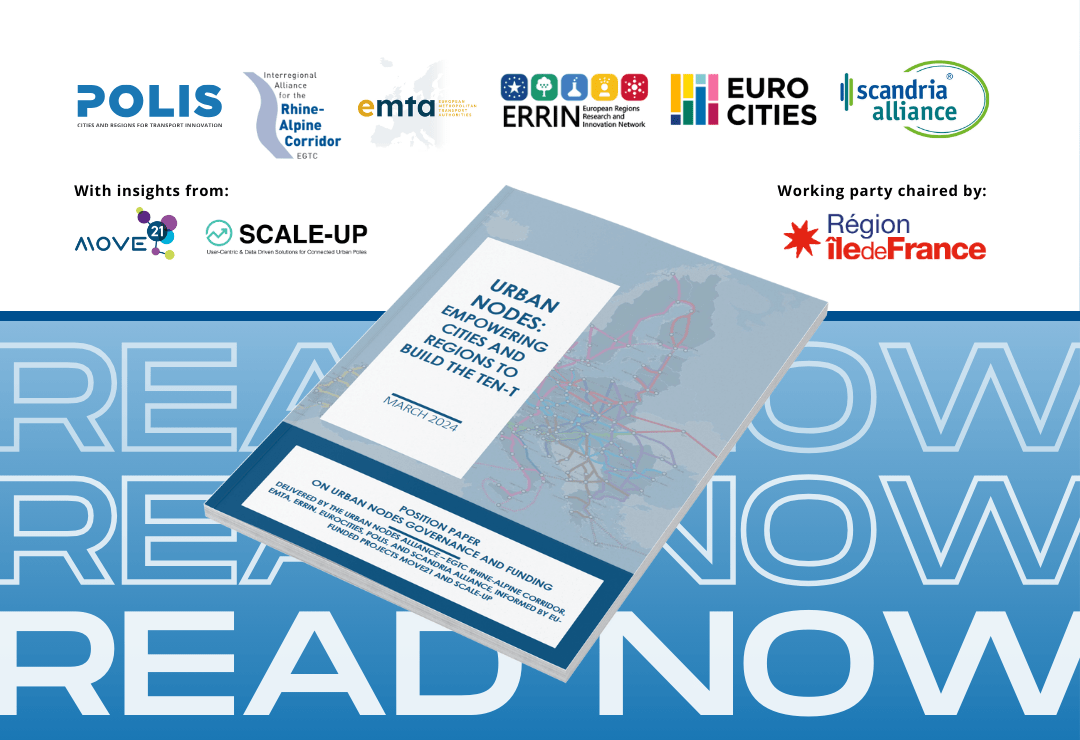Connecting Europe Days 2024: City and regional networks call for support for urban nodes within the TEN-T
During the 2024 Connecting Europe Days, the Urban Nodes Alliance jointly published the position paper ‘Urban Nodes: Empowering cities and regions to build the TEN-T’. The paper outlines the governance and funding requirements needed to ensure that urban nodes can perform their vital role within the Trans-European Transport Network (TEN-T). Find out more below!
As part of the Urban Nodes Alliance, POLIS has joined forces with EGTC - Interregional Alliance for the Rhine-Alpine Corridor, EMTA, ERRIN, Eurocities, and Scandria Alliance to issue a joint position paper, titled 'Urban Nodes: Empowering cities and regions to build the TEN-T.' The paper was released after the opening of this year's Connecting Europe Days in Brussels, where mobility leaders from across Europe joined to discuss the transition to a sustainable, smart, and resilient European transport and mobility network.
The recommendations put forward by the Alliance come as a response to the EU’s 2023 update of the TEN-T regulation, which will see the number of identified urban nodes within the network grow from 88 to 431. This marked increase highlights the critical role of local authorities in managing transportation infrastructure. To empower urban nodes to fulfill their vital role within the TEN-T, the paper calls on EU Member States for greater support.
Urban nodes: The key ingredient for a successful TEN-T
The development of the TEN-T is fundamental to securing barrier-free, safe, and sustainable movement of people and goods across the EU. Urban nodes play a pivotal role in ensuring the overall functioning, efficiency, and resilience of the network.
Urban nodes are, by definition, urban areas located at intersections of the TEN-T, where different transport modes converge for both passengers and freight. As such, they improve connectivity, resilience, and mobility across Europe's regions.
Under the current TEN-T Regulation, urban nodes are required to:
- have a Sustainable Urban Mobility Plan (SUMP) in place by 2027;
- have developed multimodal passenger hubs by 2030;
- and have at least one multimodal freight terminal each by 2040.
New SUMPs will prioritise sustainability, safety, and accessibility of mobility within cities, while greater multimodal capacity within urban nodes will allow cities to address first and last-mile delivery challenges, improving the efficiency of freight transportation within functional urban areas (FUAs).
Pushing for greater support
Despite their importance for the TEN-T, urban nodes and FUAs across the EU lack uniform governance structures and jurisdiction over areas of transport or environmental policy. Often, there is also a disconnect between what is being negotiated at the international level and what is required at the local level.
The networks, territorial groupings, and EU-funded research projects brought together by the Urban Nodes Alliance have clear recommendations to provide policymakers concerning stakeholder engagement and effective mobility governance at the local level. All partners in the Alliance emphasise the need for adequate financial resources and call specifically for the continuation of the Connecting Europe Facility (CEF) or a similar funding mechanism to support the achievement of TEN-T requirements.
Cities and regions for a better TEN-T
Under the leadership of the Île de France Region, and with insights from the Horizon Europe Projects MOVE21 and SCALE-UP, the Urban Nodes Alliance partners have published new recommendations for a stronger TEN-T.
Their joint position paper invites EU Member States to initiate or accelerate the dialogue with local, regional, and transport authorities with the view of establishing appropriate governance structures for designated urban nodes as soon as possible.
The full position paper and its recommendations are available here.
To find out more about the launch of the position paper, read the press release here.


